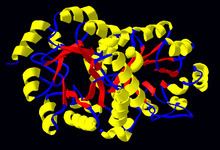EC number 4.1.1.23 ExPASy NiceZyme view | CAS number 9024-62-8 | |
 | ||
Orotidine 5’-phosphate decarboxylase (OMP decarboxylase) or orotidylate decarboxylase is an enzyme involved in pyrimidine biosynthesis. It catalyzes the decarboxylation of orotidine monophosphate (OMP) to form uridine monophosphate (UMP). The function of this enzyme is essential to the de novo biosynthesis of the pyrimidine nucleotides uridine triphosphate, cytidine triphosphate, and thymidine triphosphate. OMP decarboxylase has been a frequent target for scientific investigation because of its demonstrated extreme catalytic efficiency and its usefulness as a selection marker for yeast strain engineering.
Contents
Catalysis
OMP decarboxylase is known for being an extraordinarily efficient catalyst capable of accelerating the uncatalyzed reaction rate by a factor of 1017. To put this in perspective, a reaction that would take 78 million years in the absence of enzyme takes 18 milliseconds when it is enzyme catalyzed. This extreme enzymatic efficiency is especially interesting because OMP decarboxylases uses no cofactor and contains no metal sites or prosthetic groups. The catalysis relies on a handful of charged amino acid residues positioned within the active site of the enzyme.
The exact mechanism by which OMP decarboxylase catalyzes its reaction has been a subject of rigorous scientific investigation. The driving force for the loss of the carboxyl linked to the C6 of the pyrimidine ring comes from the close proximity of an aspartate residue carboxyl group in the enzyme's active site, which destabilizes the ground state relative to the transition state of the uncatalyzed reaction. There have been multiple hypotheses about what form the transition state takes before protonation of the C6 carbon occurs to yield the final product. Many studies investigated the binding of a potent inhibitor of OMP decarboxylase, 6-hydroxy uridine monophosphate (BMP, a barbituric acid derivative), within the active site, to identify which essential amino acid residues are directly involved with stabilization of the transition state. (See figure of enzyme bound to BMP) Several mechanisms for enzymatic decarboxylation of OMP have been proposed, including protonation at O2 to form a zwitterionic species as an intermediate, anion stabilization of O4, or nucleophilic attack at C5. Current consensus suggests that the mechanism proceeds through a stabilized carbanion at the C6 after loss of carbon dioxide. This mechanism was suggested from studies investigating kinetic isotope effects in conjunction with competitive inhibition and active site mutagenesis. In this mechanism the short-lived carbanion species is stabilized by a nearby lysine residue, before it is quenched by a proton. (See schematic of catalytic mechanism)
OMP decarboxylase vs UMP synthase
In yeast and bacteria, OMP decarboxylase is a single-function enzyme. However, in mammals, OMP decarboxylase is part of a single protein with two catalytic activities. This bifunctional enzyme is named UMP synthase and it also catalyzes the preceding reaction in pyrimidine nucleotide biosynthesis, the transfer of ribose 5-phosphate from 5-phosphoribosyl-1-pyrophosphate to orotate to form OMP. In organisms utilizing OMP decarboxylase, this reaction is catalyzed by orotate phosphoribosyltransferase.
Importance in yeast genetics
Mutations in the gene encoding OMP decarboxylase in yeast (URA3) leads to auxotrophy in uracil. in addition, a function OMP decarboxylase renders yeast strains sensitive to the molecule 5-fluoroorotic acid (5-FOA). The establishment of the URA3 gene as a selection marker with both positive and negative selection strategies has made the controlled expression of OMP decarboxylase a significant laboratory tool for the investigation of yeast genetics.
